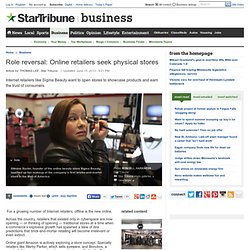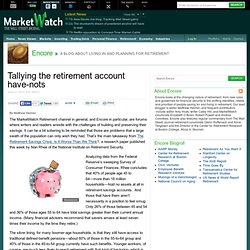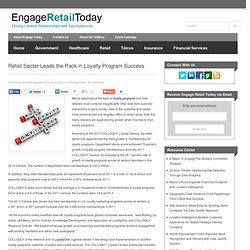

High-performing Market Research Executive with both hands-on and management experience within the Consumer Packaged Goods industry. Recognized analytical leader
Walmart vs. Costco: How Do They Really Compare? 5 Retailers That Get Mobile. The majority of retailers now understand the importance of mobile, although many still struggle with how best to adopt it.

The obvious mobile opportunity for retail is to bridge the in-store and online gap. That means implementing a mobile strategy that helps consumers make purchase decisions in the store and make checkout easier. Research shows retailers will generate approximately $689 billion through mobile-influenced sales in 2016. Currently, 58 percent of smartphone owners use mobile for in-store related shopping and are more likely to convert in-store as a result.
Payments: 'tap and go' is so 2012. Google co-founder Sergey Brin showcases Google Glass at Google I/O 2012.

Photo: Reuters If Google gets its way, in the near future we’ll be able to walk into a store wearing our Google glasses, see the price of an item projected on the lens and make the payment just by tapping the glasses frame. This might be a scary thought for anyone who can’t resist an impulse purchase, but it’s a revolution for retailers. News, weather, sports. For a growing number of Internet retailers, offline is the new online.

Across the country, retailers that existed only in cyberspace are now opening — or thinking of opening — traditional stores at a time when e-commerce’s explosive growth has spawned a slew of dire predictions that brick-and-mortar retailing will become irrelevant or even extinct. Online giant Amazon is actively exploring a store concept. Specialty retailers like Warby Parker, which sells eyeware, and Bonobos, a men’s clothing company, already operate stores. Mobile Shopping and Affluent Consumers. Tallying the retirement account have-nots - Encore. By Matthew Heimer The MarketWatch Retirement channel in general, and Encore in particular, are forums where writers and readers wrestle with the challenges of building and preserving their savings.

It can be a bit sobering to be reminded that those are problems that a large swath of the population can only wish they had. That’s the main takeaway from The Retirement Savings Crisis: Is It Worse Than We Think? , a research paper published this week by Nari Rhee of the National Institute on Retirement Security. Shutterstock Analyzing data from the Federal Reserve’s sweeping Survey of Consumer Finances, Rhee concludes that 40% of people age 45 to 64—more than 18 million households—hold no assets at all in retirement savings accounts. 7 Tips To Create Compelling Signage For Your Store - 21inShareinShare You’ve probably seen me rail about poor signage choices on TV, or you’ve read my Facebook posts with pictures of bad signage, or you read my post Retail Signage: Examples of How Not To Talk To Your Customers and you may have felt, well then what should we do to create compelling signs in our store… Glad you asked because some of the greatest sins in retailing are the lack of signage, their lack of personality and the confusing message they often convey to customers.

Signage should be front and center when you are creating a window display or a product display. Retail Sector Leads the Pack in Loyalty Program Success. We’ve talked about the topic of loyalty programs and how retailers must combine insights with other data from customer interactions to get a holistic view of the customer and create more personalized and targeted offers.

A recent study finds that many retailers are experiencing growth when it comes to their loyalty programs. According to the 2013 COLLOQUY Loyalty Census, the retail sector has experienced the most growth in memberships for loyalty programs. Department stores alone achieved 70 percent growth in loyalty program memberships since the 2011 COLLOQUY Census, far surpassing the 26.7 percent rate of growth in loyalty programs across all sectors tabulated in the 2013 Census. The number of department store memberships is 193.9 million.
In addition, drug store memberships grew an impressive 45 percent since 2011 to a total of 142.4 million and specialty retail programs rose to 360.5 million for a 26% increase since 2011. Reclaiming the Four Walls: Top Five Brick-and-Mortar Retail Trends in 2013. By Shelley E.

Kohan, shelley@retailnext.net Retail’s four walls are the most valuable marketing assets out there today. Gourmet Retailer Mobile. To hear Peter Martino, CEO at Annapolis, Md.

-based Capital Teas LLC and speaker at the recently completed World Tea Expo, tell it, getting traditionally coffee-crazed Americans to drink specialty tea requires retailers to understand several key things: the history of tea in the United States as a way to educate consumers; trends related to the evolving consumer palate; how tea-brewing methods affect consumer needs, with an emphasis on ease, convenience and fun; and how to raise tea sales through knowledge of consumer preferences.
Throughout his June 8 presentation, “Selling Specialty Teas to the American Consumer,” Martino continually emphasized those points. As it is, specialty tea consumption in the United States risen 500 percent of late, according to Martino, as Americans come to see hot tea as part of their national identity and increasingly consider tea a healthier beverage choice than carbonated soft drinks, which are currently leaking sales.